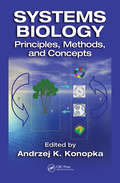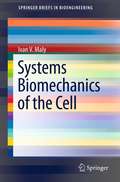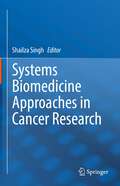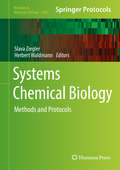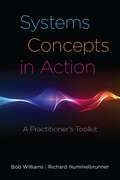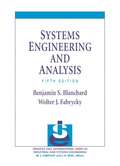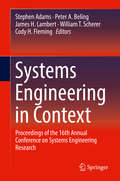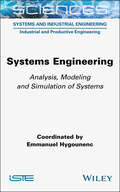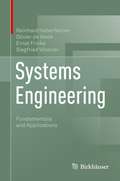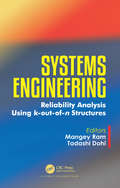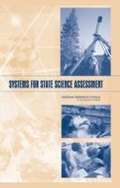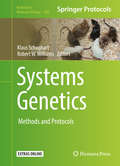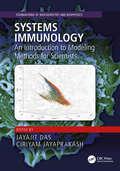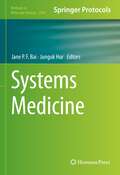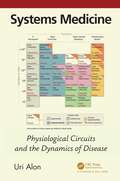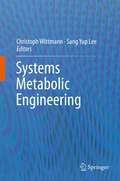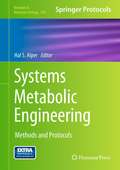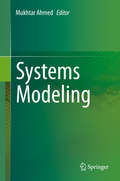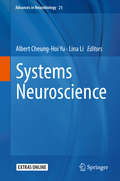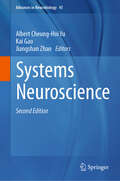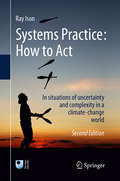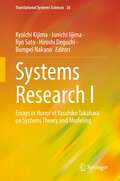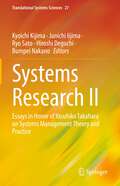- Table View
- List View
Systems Biology: Principles, Methods, and Concepts
by Andrzej K. KonopkaWith extraordinary clarity,the Systems Biology: Principles, Methods, and Concepts focuses on the technical practical aspects of modeling complex or organic general systems. It also provides in-depth coverage of modeling biochemical, thermodynamic, engineering, and ecological systems. Among other methods and concepts based in logic, computer
Systems Biomechanics of the Cell
by Ivan V. MalySystems Biomechanics of the Cell attempts to outline systems biomechanics of the cell as an emergent and promising discipline. The new field owes conceptually to cell mechanics, organism-level systems biomechanics, and biology of biochemical systems. Its distinct methodology is to elucidate the structure and behavior of the cell by analyzing the unintuitive collective effects of elementary physical forces that interact within the heritable cellular framework. The problematics amenable to this approach includes the variety of cellular activities that involve the form and movement of the cell body and boundary (nucleus, centrosome, microtubules, cortex, and membrane). Among the elementary system effects in the biomechanics of the cell, instability of symmetry, emergent irreversibility, and multiperiodic dissipative motion can be noted. Research results from recent journal articles are placed in this unifying framework. It is suggested that the emergent discipline has the potential to expand the spectrum of questions asked about the cell, and to further clarify the physical nature of animate matter and motion.
Systems Biomedicine Approaches in Cancer Research
by Shailza SinghThis book presents the applications of systems biology and synthetic biology in cancer medicine. It highlights the use of computational and mathematical models to decipher the complexity of cancer heterogeneity. The book emphasizes the modeling approaches for predicting behavior of cancer cells, tissues in context of drug response, and angiogenesis. It introduces cell-based therapies for the treatment of various cancers and reviews the role of neural networks for drug response prediction. Further, it examines the system biology approaches for the identification of medicinal plants in cancer drug discovery. It explores the opportunities for metabolic engineering in the realm of cancer research towards development of new cancer therapies based on metabolically derived targets. Lastly, it discusses the applications of data mining techniques in cancer research. This book is an excellent guide for oncologists and researchers who are involved in the latest cancer research.
Systems Chemical Biology: Methods and Protocols (Methods in Molecular Biology #1888)
by Herbert Waldmann Slava ZieglerThis volume explores the latest available wet-lab techniques and computational methods to study in-cell small-molecule behavior and interactions with their targets. The chapters in this book discuss topics such as disease-relevant models for chemical biology studies, target engagement using cellular thermal shift assay or bioluminescence resonance energy transfer; visualization of bio-active small molecules Raman microscopy; (phospho-)proteomics and transcriptomics for mode-of-action studies, CRISPR/Cas9-based chemogenomic profiling in mammalian cells; predicting drug interactions using computational approaches; comparison of compound-induced profiles using high-content imaging or cancer cell line panels and web-based tools for polypharmacology prediction. Written in the highly successful Methods in Molecular Biology series format, chapters include introductions to their respective topics, lists of the necessary materials and reagents, step-by-step, readily reproducible laboratory protocols, and tips on troubleshooting and avoiding known pitfalls. Cutting-edge and thorough, Systems Chemical Biology: Methods and Protocols is a valuable resource for novice or expert scientists and researchers trying to initiate or continue their chemical biology studies at a systems level.
Systems Concepts in Action: A Practitioner's Toolkit
by Bob Williams Richard HummelbrunnerSystems Concepts in Action: A Practitioner's Toolkit explores the application of systems ideas to investigate, evaluate, and intervene in complex and messy situations. The text serves as a field guide, with each chapter representing a method for describing and analyzing; learning about; or changing and managing a challenge or set of problems. The book is the first to cover in detail such a wide range of methods from so many different parts of the systems field. The book's Introduction gives an overview of systems thinking, its origins, and its major subfields. In addition, the introductory text to each of the book's three parts provides background information on the selected methods. Systems Concepts in Action may serve as a workbook, offering a selection of tools that readers can use immediately. The approaches presented can also be investigated more profoundly, using the recommended readings provided. While these methods are not intended to serve as "recipes," they do serve as a menu of options from which to choose. Readers are invited to combine these instruments in a creative manner in order to assemble a mix that is appropriate for their own strategic needs.
Systems Engineering and Analysis (Prentice Hall International Series in Industrial and Systems Engineering)
by Benjamin S. Blanchard Wolter J. Fabrycky<p>For senior-level undergraduate and first and second year graduate systems engineering and related courses. Systems Engineering and Analysis, 5/e, provides a total life-cycle approach to systems and their analysis. <p>This practical introduction to systems engineering and analysis provides the concepts, methodologies, models, and tools needed to understand and implement a total life-cycle approach to systems and their analysis. The authors focus first on the process of bringing systems into being—beginning with the identification of a need and extending that need through requirements determination, functional analysis and allocation, design synthesis, evaluation, and validation, operation and support, phase-out, and disposal. Next, the authors discuss the improvement of systems currently in being, showing that by employing the iterative process of analysis, evaluation, feedback, and modification, most systems in existence can be improved in their affordability, effectiveness, and stakeholder satisfaction.</p>
Systems Engineering in Context: Proceedings of the 16th Annual Conference on Systems Engineering Research
by William T. Scherer James H. Lambert Stephen Adams Peter A. Beling Cody H. FlemingThis volume chronicles the 16th Annual Conference on System Engineering Research (CSER) held on May 8-9, 2018 at the University of Virginia, Charlottesville, Virginia, USA. The CSER offers researchers in academia, industry, and government a common forum to present, discuss, and influence systems engineering research. It provides access to forward‐looking research from across the globe, by renowned academicians as well as perspectives from senior industry and government representatives. Co‐founded by the University of Southern California and Stevens Institute of Technology in 2003, CSER has become the preeminent event for researchers in systems engineering across the globe. Topics include though are not limited to the following: Systems in context: · Formative methods: requirements · Integration, deployment, assurance · Human Factors · Safety and Security Decisions/ Control & Design; Systems Modeling: · Optimization, Multiple Objectives, Synthesis · Risk and resiliency · Collaborative autonomy · Coordination and distributed decision-making Prediction: · Prescriptive modeling; state estimation · Stochastic approximation, stochastic optimization and control Integrative Data engineering: · Sensor Management · Design of Experiments
Systems Engineering: Analysis, Modeling and Simulation of Systems
by Emmanuel HygounencThis book is intended for students, teachers, researchers, engineers and project managers wishing to understand and implement systems engineering into their work. Based on numerous bibliographical sources, it provides coherent and accessible information, complemented with numerous illustrations. Systems Engineering will enable the reader to not only understand but also master the development cycle of a system, as well as gain an in-depth understanding of the associated terminology. An introduction to systems theory is presented first, clarifying what is meant by a complex system. The book then outlines systems engineering and one of its components: requirements engineering. A detailed presentation of the downhill activities of the development cycle follows the definition of requirements and the design of systems. Finally, the book explores the upstream activities of the development cycle with the virtual and concrete integration of the system.
Systems Engineering: Fundamentals and Applications (Engineering Systems Ser.)
by Reinhard Haberfellner Olivier de Weck Ernst Fricke Siegfried VössnerThis translation brings a landmark systems engineering (SE) book to English-speaking audiences for the first time since its original publication in 1972. For decades the SE concept championed by this book has helped engineers solve a wide variety of issues by emphasizing a top-down approach. Moving from the general to the specific, this SE concept has situated itself as uniquely appealing to both highly trained experts and anybody managing a complex project. Until now, this SE concept has only been available to German speakers. By shedding the overtly technical approach adopted by many other SE methods, this book can be used as a problem-solving guide in a great variety of disciplines, engineering and otherwise.By segmenting the book into separate parts that build upon each other, the SE concept’s accessibility is reinforced. The basic principles of SE, problem solving, and systems design are helpfully introduced in the first three parts. Once the fundamentals are presented, specific case studies are covered in the fourth part to display potential applications. Then part five offers further suggestions on how to effectively practice SE principles; for example, it not only points out frequent stumbling blocks, but also the specific points at which they may appear. In the final part, a wealth of different methods and tools, such as optimization techniques, are given to help maximize the potential use of this SE concept.Engineers and engineering students from all disciplines will find this book extremely helpful in solving complex problems. Because of its practicable lessons in problem-solving, any professional facing a complex project will also find much to learn from this volume.
Systems Engineering: Reliability Analysis Using k-out-of-n Structures
by Tadashi Dohi Mangey RamA substantial amount of research has been conducted on consecutive k-out-of-n and related reliability systems over the past four decades. These systems have been used to model various engineering systems such as the microwave stations of telecoms network, oil pipeline systems, and vacuum systems in an electron accelerator. As such, studies of reliability properties of consecutive k-out-of-n structures have attracted significant attention from both theoretical and practical approaches. In the modern era of technology, the redundancies are employed in the various industrial systems to prevent them from failure/sudden failure or to recover from failures. This book is meant to provide knowledge and help engineers and academicians in understanding reliability engineering by using k-out-of-n structures. The material is also targeted at postgraduate or senior undergraduate students pursuing reliability engineering.
Systems For State Science Assessment
by Committee on Test Design for K-12 Science AchievementIn response to the No Child Left Behind Act of 2001 (NCLB), Systems for State Science Assessment explores the ideas and tools that are needed to assess science learning at the state level. This book provides a detailed examination of K-12 science assessment: looking specifically at what should be measured and how to measure it. Along with reading and mathematics, the testing of science is a key component of NCLB—it is part of the national effort to establish challenging academic content standards and develop the tools to measure student progress toward higher achievement. The book will be a critical resource for states that are designing and implementing science assessments to meet the 2007-2008 requirements of NCLB. In addition to offering important information for states, Systems for State Science Assessment provides policy makers, local schools, teachers, scientists, and parents with a broad view of the role of testing and assessment in science education.
Systems Genetics
by Klaus Schughart Robert W. WilliamsThis volume focuses on the use of system genetic methods and the use of murine models to study the role of gene variants and environmental factors on human health and disease--what is now often called personalized or precision health care. The protocols in this book will help readers analyze genetic causes of heritable variation across a wide range of systems and traits using rodent models. The chapters in this book are separated into three sections that cover: 1) resources for systems genetics; 2) tools for analysis and integration in systems genetics; and 3) systems genetics use cases. Written in the highly successful Methods in Molecular Biology series format, chapters include introductions to their respective topics, lists of the necessary materials and tools, step-by-step, readily reproducible protocols, and tips on troubleshooting and avoiding known pitfalls. Practical and thorough, Systems Genetics: Methods and Protocols is a valuable resource for anyone who is interested in this diverse field.
Systems Genetics: Linking Genotypes and Phenotypes
by Florian Markowetz Michael BoutrosWhereas genetic studies have traditionally focused on explaining heritance of single traits and their phenotypes, recent technological advances have made it possible to comprehensively dissect the genetic architecture of complex traits and quantify how genes interact to shape phenotypes. This exciting new area has been termed systems genetics and is born out of a synthesis of multiple fields, integrating a range of approaches and exploiting our increased ability to obtain quantitative and detailed measurements on a broad spectrum of phenotypes. Gathering the contributions of leading scientists, both computational and experimental, this book shows how experimental perturbations can help us to understand the link between genotype and phenotype. A snapshot of current research activity and state-of-the-art approaches to systems genetics are provided, including work from model organisms such as Saccharomyces cerevisiae and Drosophila melanogaster, as well as from human studies.
Systems Immunology: An Introduction to Modeling Methods for Scientists (Foundations of Biochemistry and Biophysics)
by Jayajit Das Ciriyam Jayaprakash"Taken together, the body of information contained in this book provides readers with a bird’s-eye view of different aspects of exciting work at the convergence of disciplines that will ultimately lead to a future where we understand how immunity is regulated, and how we can harness this knowledge toward practical ends that reduce human suffering. I commend the editors for putting this volume together." –Arup K. Chakraborty, Robert T. Haslam Professor of Chemical Engineering, and Professor of Physics, Chemistry, and Biological Engineering, Massachusetts Institute of Technology, Cambridge, USA New experimental techniques in immunology have produced large and complex data sets that require quantitative modeling for analysis. This book provides a complete overview of computational immunology, from basic concepts to mathematical modeling at the single molecule, cellular, organism, and population levels. It showcases modern mechanistic models and their use in making predictions, designing experiments, and elucidating underlying biochemical processes. It begins with an introduction to data analysis, approximations, and assumptions used in model building. Core chapters address models and methods for studying immune responses, with fundamental concepts clearly defined. Readers from immunology, quantitative biology, and applied physics will benefit from the following: Fundamental principles of computational immunology and modern quantitative methods for studying immune response at the single molecule, cellular, organism, and population levels. An overview of basic concepts in modeling and data analysis. Coverage of topics where mechanistic modeling has contributed substantially to current understanding. Discussion of genetic diversity of the immune system, cell signaling in the immune system, immune response at the cell population scale, and ecology of host-pathogen interactions.
Systems Medicine (Methods in Molecular Biology #2486)
by Jane P. F. Bai Junguk HurThis volume explores the latest technological advances and covers all facets of systems medicine with respect to precision medicine. The chapters in this book are organized into four parts. Part One highlights the recent achievements in proteomics for biomarkers identification, integration of omics and phenotypic data for precision medicine, and medicine-guided treatment of drug-induced Stevens-Johnson syndrome. Part Two covers systems-based computational approaches for pharmaceutical research and drug development, the principle of optimizing systemic exposure of drugs, and Animal Rule for drug repurposing. Part Three looks at computational tools and methodologies of network biology, quantitative systems toxicology, and modeling and stimulating patient response variabilities. Part Four talks about how systems medicine can address unmet medical and health needs, and identify educational needs. Written in the highly successful Methods in Molecular Biology series format, chapters include introductions to their respective topics, lists of the necessary materials and reagents, step-by-step, readily reproducible laboratory protocols, and tips on troubleshooting and avoiding known pitfalls.Cutting-edge and thorough, Systems Medicine: Methods and Protocols is a valuable resource for the scientific community that will help researchers work together toward the further advancement of achieving the goal of promoting global health.Chapter 8 is available open access under a Creative Commons Attribution 4.0 International License via link.springer.com
Systems Medicine: Physiological Circuits and the Dynamics of Disease (Chapman & Hall/CRC Computational Biology Series)
by Uri AlonWhy do we get certain diseases, whereas other diseases do not exist? In this book, Alon, one of the founders of systems biology, builds a foundation for systems medicine. Starting from basic laws, the book derives why physiological circuits are built the way they are. The circuits have fragilities that explain specific diseases and offer new strategies to treat them. By the end, the reader will be able to use simple and powerful mathematical models to describe physiological circuits. The book explores, in three parts, hormone circuits, immune circuits, and aging and age-related disease. It culminates in a periodic table of diseases. Alon writes in a style accessible to a broad range of readers - undergraduates, graduates, or researchers from computational or biological backgrounds. The level of math is friendly and the math can even be bypassed altogether. For instructors and readers who want to go deeper, the book includes dozens of exercises that have been rigorously tested in the classroom
Systems Metabolic Engineering
by Sang Yup Lee Christoph WittmannSystems Metabolic Engineering is changing the way microbial cell factories are designed and optimized for industrial production. Integrating systems biology and biotechnology with new concepts from synthetic biology enables the global analysis and engineering of microorganisms and bioprocesses at super efficiency and versatility otherwise not accessible. Without doubt, systems metabolic engineering is a major driver towards bio-based production of chemicals, materials and fuels from renewables and thus one of the core technologies of global green growth. In this book, Christoph Wittmann and Sang-Yup Lee have assembled the world leaders on systems metabolic engineering and cover the full story - from genomes and networks via discovery and design to industrial implementation practises. This book is a comprehensive resource for students and researchers from academia and industry interested in systems metabolic engineering. It provides us with the fundaments to targeted engineering of microbial cells for sustainable bio-production and stimulates those who are interested to enter this exiting research field.
Systems Metabolic Engineering
by Hal S. AlperWith the ultimate goal of systematically and robustly defining the specific perturbations necessary to alter a cellular phenotype, systems metabolic engineering has the potential to lead to a complete cell model capable of simulating cell and metabolic function as well as predicting phenotypic response to changes in media, gene knockouts/overexpressions, or the incorporation of heterologous pathways. In Systems Metabolic Engineering: Methods and Protocols, experts in the field describe the methodologies and approaches in the area of systems metabolic engineering and provide a step-by-step guide for their implementation. Four major tenants of this approach are addressed, including modeling and simulation, multiplexed genome engineering, 'omics technologies, and large data-set incorporation and synthesis, all elucidated through the use of model host organisms. Written in the highly successful Methods in Molecular BiologyTM series format, chapters include introductions on their respective topics, lists of the necessary materials and reagents, step-by-step, readily reproducible laboratory protocols, and tips on troubleshooting and avoiding known pitfalls. Comprehensive and cutting-edge, Systems Metabolic Engineering: Methods and Protocols serves as an ideal guide for metabolic engineers, molecular biologists, and microbiologists aiming to implement the most recent approaches available in the field.
Systems Modeling
by Mukhtar AhmedAchieving food security and economic developmental objectives in the face of climate change and rapid population growth requires systems modelling approaches, for example in the design of sustainable agriculture farming systems. Such approaches increase our understanding of system responses to different soil and climatic conditions, and provide insights into the effects of various variable climate change scenarios, providing valuable information for decision-makers. Further, in the agricultural sector, systems modelling can help optimise crop management and adaptation measures to boost productivity under variable climatic conditions. Presenting key outcomes from crop models used in agricultural systems this book is a valuable resource for professionals interested in using modelling approaches to manage the growth and improve the quality of various crops.
Systems Neuroscience (Advances in Neurobiology #21)
by Albert Cheung-Hoi Yu Lina LiThis edition of Advances in Neurobiology brings together experts in the emerging field of Systems Neuroscience to present an overview of this area of research. Topics covered include: how different neural circuits analyze sensory information, form perceptions of the external world, make decisions, and execute movements; how nerve cells behave when connected together to form neural networks; the relationship between molecular and cellular approaches to understanding brain structure and function; the study of high-level mental functions; and studying brain pathologies and diseases with Systems Neuroscience. A hierarchy of biological complexity arises from the genome, transcriptome, proteome, organelles, cells, synapses, circuits, brain regions, the whole brain, and behaviour. The best way to study the brain, the most complex organ in the body composed of 100 billion cells with trillions of interconnections, is with a Systems Biology approach. Systems biology is an inter-disciplinary field that focuses on complex interactions within biological systems to reveal 'emergent properties' - properties of cells and groups of cells functioning as a system whose actual and theoretical description is only possible using Systems Biology techniques.
Systems Neuroscience (Advances in Neurobiology #41)
by Albert Cheung-Hoi Yu Kai Gao Jiangshan ZhanThe new edition of this popular book brings together experts in the field of Systems Neuroscience to present an overview of the area. Topics covered include how different neural circuits analyze sensory information, form perceptions of the external world, make decisions, and execute movements; how nerve cells behave when connected together to form neural networks; the relationship between molecular and cellular approaches to understanding brain structure and function; the study of high-level mental functions; and studying brain pathologies and disease. Among the topics covered in the new edition are artificial intelligence-assisted computational neuroscience for deciphering neural networks, spatial transcriptomics single cell sequencing, and exome/whole genome sequencing for understanding brain disorders in human genetics. The best way to study the brain, the most complex organ in the body composed of 100 billion neurons with trillions of interconnections, is with a systems biology approach.
Systems Orthodontics: From Clinical Reasoning to Computation, and Back (Understanding Complex Systems)
by Guido Caldarelli Pietro Auconi Antonella PolimeniThis book marks one of the first applications of the Medicine Network discipline to an everyday scenario. It explores situations where patients, often in adolescence, grapple with the decision of whether to commence a treatment, seeking insights into the more plausible future scenarios. Additionally, the specific feedback from biological systems in the human body serves as a potent metaphor for addressing various challenges in the field of Complex Systems. In recent times, systems thinking and complexity theory have yielded substantial conceptual advancements across various research domains. In the context of orthodontics, these approaches offer a more comprehensive understanding in contrast to the traditional mechanistic approach, which primarily focuses on the analysis of applied forces. Systems thinking directs attention to the interaction among dentoskeletal components, where the behavior of one element can influence others. The amalgamation of multiple elements leads to entities with properties distinct from those of individual components. The increasing complexity of orthodontic reality beyond clinical or radiological observations necessitates the development of new theories. Complexity theory has demonstrated that emergent properties in biological systems can be discerned through appropriate computational models, as opposed to the analytical study of individual components. The central metaphor for the interactive craniofacial system during growth is portrayed by the facial topology revealed through network analysis, facilitating a systemic reevaluation of traditional orthodontic theories. This book delineates the novel insights derived from the clinical-computational approach, applicable for a prognostic and early interception perspective in managing dentofacial dysmorphoses. Its objective is to captivate practitioners and persuade them of the practical utility of these innovative approaches.
Systems Practice: How to Act
by Ray IsonIt is now accepted that humans are changing the climate of the Earth and this is the most compelling amongst a long litany of reasons as to why, collectively, we have to change our ways of thinking and acting. Most people now recognise that we have to be capable of adapting quickly as new and uncertain circumstances emerge: this capability will need to exist at personal, group, community, regional, national and international levels, all at the same time. Systems Practice is structured into four parts. Part I introduces the societal need to move towards a more systemic and adaptive governance against the backdrop of human-induced climate change. Part II unpacks what is involved in systems practice by means of a juggler metaphor; examining situations where systems thinking offers useful understanding and opportunities for change. Part III identifies the main factors that constrain the uptake of systems practice and makes the case for innovation in practice by means of systemic inquiry, systemic action research and systemic intervention. The book concludes with Part IV, which critically examines how systems practice is, or might be, utilised at different levels from the personal to the societal. The development of our capabilities to think and act systemically is an urgent priority and Systems Practice aims to show how to do systems thinking and translate that thinking into praxis (theory informed practical action) which will be welcomed by those managing in situations of complexity and uncertainty across all domains of professional and personal concern.
Systems Research I: Essays in Honor of Yasuhiko Takahara on Systems Theory and Modeling (Translational Systems Sciences #26)
by Kyoichi Kijima Hiroshi Deguchi Ryo Sato Junichi Iijima Bumpei NakanoThis book is in honor of Yasuhiko Takahara, a first-class researcher who has been active for some 50 years at the global level in systems research. Researchers and practitioners from Japan and other countries who have been influenced by Takahara have come together from far and wide to contribute their major research masterpieces in the field of systems research in the broadest sense.While the roots of Takahara’s systems research are in general systems theory and systems control theory, he developed his research and teaching in diverse directions such as management information science, engineering, social simulation, and systems thinking. As a result, many of the researchers and practitioners he supervised or influenced have established their own positions and are now active around the world in a wide range of systems research.Volume I is a collection of their masterpieces or representative works in the field of systems theory and modeling.
Systems Research II: Essays in Honor of Yasuhiko Takahara on Systems Management Theory and Practice (Translational Systems Sciences #27)
by Kyoichi Kijima Hiroshi Deguchi Ryo Sato Junichi Iijima Bumpei NakanoThis book is in honor of Yasuhiko Takahara, a first-class researcher who has been active for some 50 years at the global level in systems research. Researchers and practitioners from Japan and other countries who have been influenced by Takahara have come together from far and wide to contribute their major research masterpieces in the field of systems research in the broadest sense.While the roots of Takahara’s systems research are in general systems theory and systems control theory, he developed his research and teaching in diverse directions such as management information science, engineering, social simulation, and systems thinking. As a result, many of the researchers and practitioners he supervised or influenced have established their own positions and are now active around the world in a wide range of systems research.Volume II is a collection of their masterpieces or representative works in the fields of systems management theory and practice.
